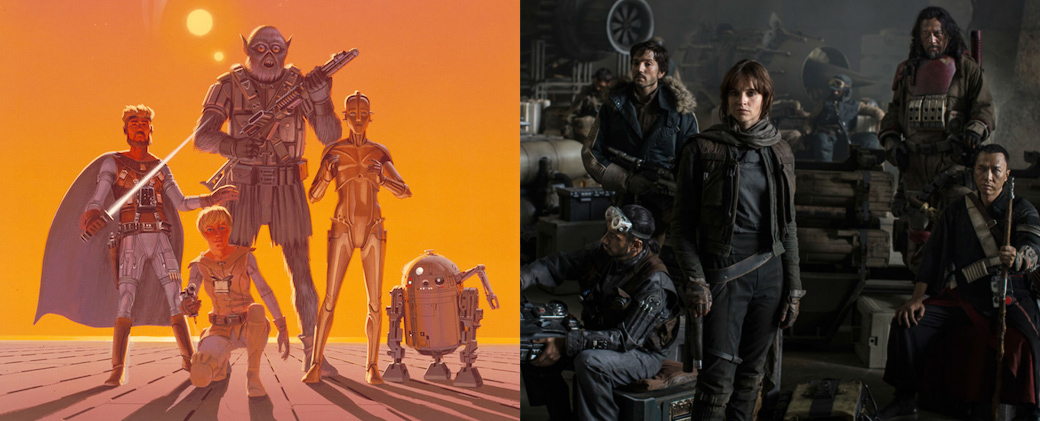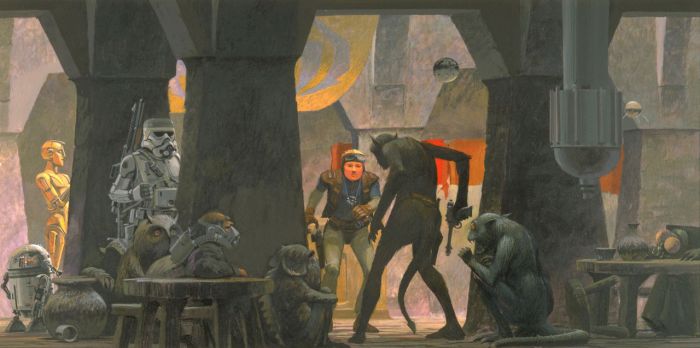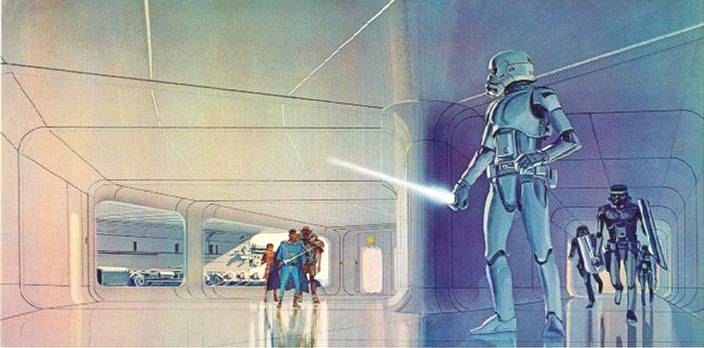
After Watching “Rogue One” multiple times last weekend I was surprised by the similarities between it and George Lucas’s “The Star Wars,” his original draft for what would eventually become “Star Wars Episode IV: A New Hope.” I just re-read “The Star Wars,” which you can find here, and I’ve broken down the similarities between it and “Rogue One” chronologically. Obviously there are plenty of spoilers ahead, so reader be warned!
The Whills
One of Lucas’s early drafts mentions the Journal of the Whills, and the film was even subtitled this at one point. In “Rogue One” the protectors of the Jedi temples on the planet Jedha are called the Guardians of the Whills, a nice nod to Lucas and an intriguing bit of world building.
The Opening Scene
Anakin Starkiller, his brother Deak and his father Kane are hiding from the Empire on a small settlement on a barren planet. The Empire sends a Sith Warrior in a lone ship that lands on the outskirts of the settlement and the Sith attacks and kills Deak. This opening of Lucas’s original draft is very similar to the opening of “Rogue One,” in which Orson Krennic and his Death Troopers find Galen Erso and his family hiding on a farm on a similarly barren planet and end up killing Galen’s wife.
Spies and Intelligence
On Alderaan, the capital world of the Empire in “The Star Wars,” Clieg Whitsun, a Rebel spy, meets with Bail Antilles, another Rebel, to get information about the Empire’s movement to attack Aquilae, including news of a new “giant space fortress” as big as a moon that the Empire has constructed. They are then confronted by Imperial troops and Whitsun narrowly escapes. This is closely mirrored in an early scene in “Rogue One” in which Rebel Intelligence agent Cassian Andor meets with another Rebel who has information about the Death Star and then has to flee from Stormtroopers.
Political Debate
On Aquilae, the last bastion of the Rebellion, King Kayos argues with other Rebel leaders about going to war with the Empire, as it is threatening to attack unless they sign a treaty. These scenes of politicians desperately arguing over how to proceed are echoed in “Rogue One.”
The Force of Others
King Kayos, and later others characters say “May the force of others be with you all.” In “Rogue One,” this mantra is repeated by blind Guardian of the Whills Chirrut Imwe.
More Machine Than Man
Kane Starkiller, one of the last of the Jedi Bendu and a bitter enemy of the Empire, reveals that he is more machine than man–his chest and limbs are mostly mechanical. He then sacrifices his life to provide the Rebels with a means of escape. This character is very reminiscent of “Rogue One’s” Saw Gerrera, a militant rebel who is part machine and chooses to stay on Jedha to die when the Empire partially destroys the planet.

Re-purposed Imperial Droids
R2-D2 and C3PO were originally imperial robots on the Empire’s Death Star space fortress who deserted to join the Rebels. Aside from the fact that R2 speaks English, they’re pretty much identical to the R2 and 3PO found in the actual film, but their Imperial origins remind me of “Rogue One”’s K2SO, a reprogrammed Imperial Strategy droid who works for the Rebels.
Stolen Imperial Vessels
In “The Star Wars,” our heroes travel in a stolen Imperial ship, similar to the stolen Imperial freighter in “Rogue One.”
Violence and a Darker Tone
“The Star Wars” is way more violent than “A New Hope” and has a grittier, darker tone to it. The Rebel stronghold on Aquilae is filled with political traitors, one of whom is cut in two when he is found out. A family is found dead hanging upside down, the Sith torture the civilians and General Skywalker slices people in two and “from chin to groin.” The violence is similarly more brutal in “Rogue One,” as is the tone, which has a sense of cynicism, fear and despair to it, though ending on a hopeful note.
Air Tanks
The Imperial soldiers use air tanks in battle, similar to the one used by the imperials in “Rogue One” on Jeddah
Child in Hiding
Biggs, a little boy and one of the princes of Aquilae, has to hide under a trap door from stormtroopers who are searching for him, similar to how Jyn has to hide from the Death Troopers.
Imperial Defectors
Valorum, a First Knight of the Sith and basically a sympathetic version of Darth Vader, defects to the Rebels and helps them defeat the Empire at the end of “The Star Wars.” He’s driven by a deep code of honor, and though he’s not very similar to the Imperial defector Bodhi Rook in “Rogue One,” a lowly pilot who defects out of moral outrage, both characters are instrumental in leading the Rebel heroes to victory.

I’m not sure how many of these similarities were intentionally inspired by Lucas’s early drafts of Star Wars, but I’d like to think that at least some of them were. “The Star Wars” is actually a pretty good script and an engaging read, filled to the brim with exciting sci-fi adventure plus concepts and plot points that Lucas would later use in “The Empire Strikes Back,” “Return of the Jedi” and even his Star Wars prequel trilogy. I recommend reading it if you’re a fan of the series. May the force of others be with you!
